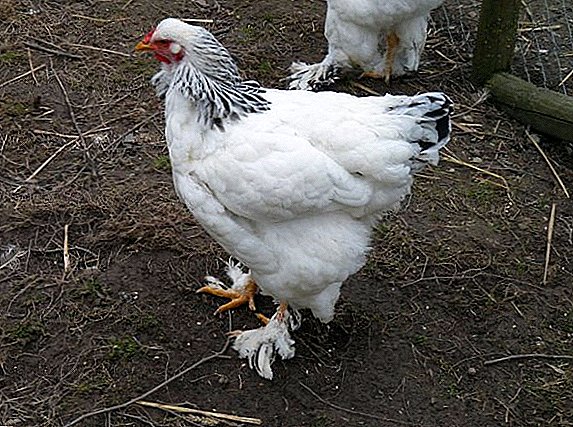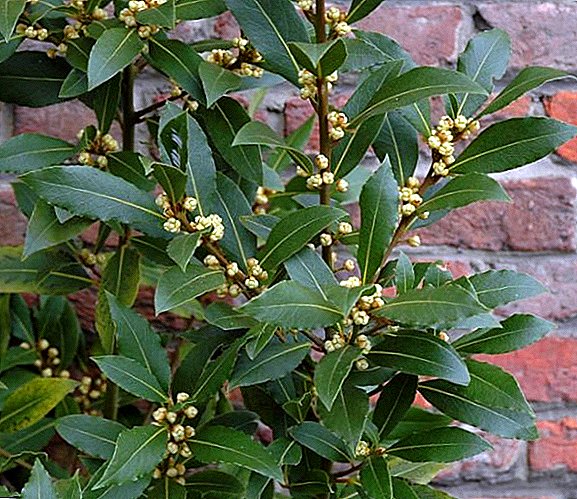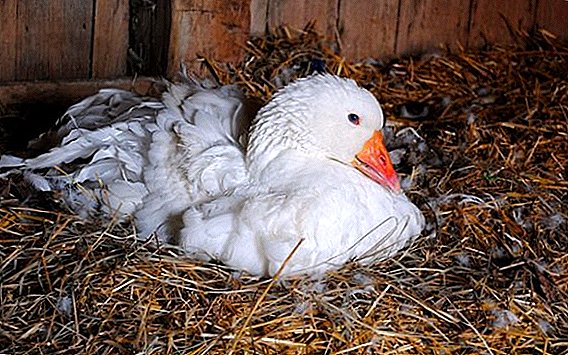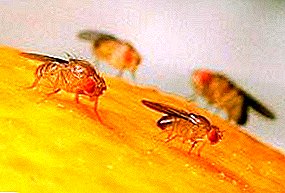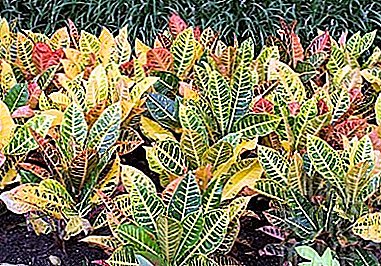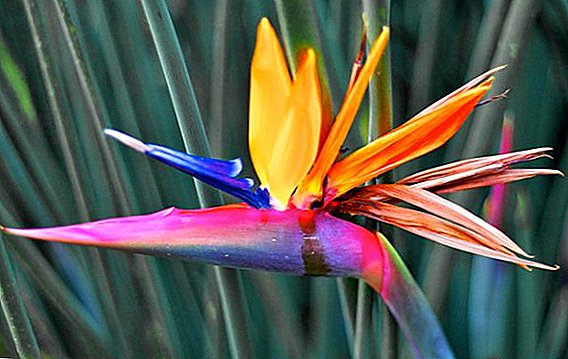 Many flowers came to our house from exotic countries and require special treatment. The beautiful Strelitzia is one of such foreign women. Let's talk about how to grow and care for whimsical Strelitzia at home, constantly admiring its exquisite flowering.
Many flowers came to our house from exotic countries and require special treatment. The beautiful Strelitzia is one of such foreign women. Let's talk about how to grow and care for whimsical Strelitzia at home, constantly admiring its exquisite flowering.
Popular species
Strelitzia came to our region from South Africa and Madagascar. It belongs to the family of the Strelitzievs (lat. Strelitziaceae). This flower was named after the wife of King George III Charlotte-Sofia Mecklenburg-Strelitz, which was also known for its love for plants and its influence on the development of the royal Botanical Garden. In nature, there are only 5 species of this exotic plant:
1. Strelitzia white (Strelitzia alba) - more like a tree than a flower or shrub. Reaches a height of 6 meters and is characterized by huge massive leaves up to 1.5-2 meters long. The flower has a dark purple color with a white core.
2. Strelitzia Nicholas (Strelitzia nicolai) is named after Russian emperor Nicholas I. This powerful evergreen plant grows up to 12 meters in height. Peduncle is dark with a purple tint, and the petals are white with blue, up to 50 cm in length.  3. Mountain strelitzia (Strelitzia caudata) or African desert banana is a huge (up to 8 meters in height) tree-like plant, more like a palm tree. The inflorescences of this species, 45-50 cm in size, are especially impressive with brown-red coloring with white petals. This species is common in South Africa and Swaziland, and it is almost impossible to find it anywhere else.
3. Mountain strelitzia (Strelitzia caudata) or African desert banana is a huge (up to 8 meters in height) tree-like plant, more like a palm tree. The inflorescences of this species, 45-50 cm in size, are especially impressive with brown-red coloring with white petals. This species is common in South Africa and Swaziland, and it is almost impossible to find it anywhere else.
4. Royal Strelitzia - (Strelitzia reginae) is the most common species in the world, and not only at home in Africa. This low shrub up to 1.5 meters tall has leaves that are very reminiscent of banana. This is the kind that can be seen in our flower shops or in a pot at home.  5. Strelitzia The reed or African desert banana (Strelitzia juncea) has recently become a separate species, as its flowers resemble the royal stent. But genetics still found specific differences between them. Thus, a distinctive feature is thin needle-shaped leaves, reaching a height of two meters.
5. Strelitzia The reed or African desert banana (Strelitzia juncea) has recently become a separate species, as its flowers resemble the royal stent. But genetics still found specific differences between them. Thus, a distinctive feature is thin needle-shaped leaves, reaching a height of two meters.
Did you know? During the reign of Nicholas I, the South African delegation brought to St. Petersburg an unknown plant called the wild banana Natal. The curator of the botanical garden E.L. Regel planted him in a greenhouse, and a powerful tall tree like a palm tree, which turned out to be a type of strelitzia, grew. So this view and got its name Strelecius Nicholas, in honor of the emperor.
Optimal conditions and features of care
We are interested in the Royal Strelitzia, which is also called the "bird of paradise", since it is the only flower that can be grown at home in our area.
Location and lighting
It may seem to you that royal strelitzia is a capricious exotic plant. But in fact, for a lush growth and flowering you need to put quite a bit of effort. When planting we take into account that the bush is rather big and requires a lot of space. We put a pot with a flower on the east and west window, although it can be kept on the south one, providing protection from the hot summer sun. When the warm summer days are already settled, you can safely take the pot to the balcony or garden. 
Temperature
During the cold season it is important to ensure the temperature of strelice from + 12 ° C to + 15 ° C. With this mode in winter, the flower will delight you with lush bloom in summer. During the rest of the year, the plant is satisfied with the same air temperature as in your house, but not lower than + 20 ° С.
Important! Strelitzia feels great and even needs fresh air, but it does not tolerate drafts.
Watering and moisture
Since the described plant is tropical, the ground for strelice must always be wet, but do not let the water stagnate, as the roots simply rot. The same goes for air. Spray a flower regularly or do a wet blot. Water for irrigation is better to take soft, separated and warm. 
Fertilization
Strelitzia is unpretentious in the choice of soil, but prefers loam. The home plant can be fed with mineral fertilizers or organic matter, if the bush grows in the garden.
As organic matter as fertilizer for plants, use biohumus, slurry, chicken manure, nettle.The whole warm season fertilizes the beauty every 3 weeks along with watering. And from September to February, they stop the introduction of fluid, as the rest period begins.
When and how to bloom
After compliance with all the recommendations for the care, we will be able to observe how the strelitzia blooms. The flowering process lasts a couple of weeks, and flowers up to 15 cm in size unfold one by one. On a long green-gray peduncle, similar to the crane's beak, a slit appears in the middle, from which long needle-like petals resemble a bird's tuft are shown. In color, they are from yellow to bright orange, with lilac splashes.  It also happens that the plant grows for quite a long time, and you all wonder, "Why doesn’t strelitzia bloom?". There can be several reasons:
It also happens that the plant grows for quite a long time, and you all wonder, "Why doesn’t strelitzia bloom?". There can be several reasons:
- slow-flowering plant, and if it is less than 4 years old, do not wait for flowering;
- in winter, the temperature regime was not observed, up to + 14 ° С;
- too small pot or not enough space in the room;
- air or soil is overdried;
- plant attacked by disease or pests.
How to transplant at home
A young plant needs to be transplanted every spring, and the strelitzia over 4 years old can be transplanted every 2-3 years. Choose a spacious and high pot, as the strelitzia roots grow in length. At the bottom of the pot lay thick drainage to avoid stagnant water. Ideal for a mixture of turf, leaf soil, compost and sand in a ratio of 2: 1: 1: 0.5. When transplanting carefully handle the roots, as they are fragile and easily broken. If something is damaged, lubricate this place with charcoal.  During transplantation, you can divide the flower, but more on this in the next section.
During transplantation, you can divide the flower, but more on this in the next section.
Vegetative breeding methods
There are two variants of vegetative propagation of Strelzia - by dividing the root and lateral shoots (both procedures are convenient to perform during transplantation), but they must be at least 6 years old. Side shoots are carefully separated along with the rhizome without damaging it. A new plant should have at least three shoots. New plants are planted in the pot using the same technology as transplantation of strelitzia.
Important! Young transplanted plants can not be kept under the bright summer sun, as it simply burns a fragile flower.
How to deal with possible diseases and pests
Strelitzia, like all the other flowers in your home, is prone to diseases and attacks of pests.
The main pests are the scale and spider mite. Recognize the spider mite, you can carefully examine the leaves of the plant. If you see a small cobweb or small points, as if from a needle, then you can definitely say that a new resident has settled.  The shield is recognized by sticky spots on the leaves and is rather difficult to remove from the plant. But with an integrated approach with the use of insecticides, it is possible to fight with these shkodnikami.
The shield is recognized by sticky spots on the leaves and is rather difficult to remove from the plant. But with an integrated approach with the use of insecticides, it is possible to fight with these shkodnikami.
Universal acaricides such as Aktara, Aktellik, Fitoverm, Neoron will come to the rescue. Do not forget to take the pot to the balcony or garden during processing.
If the leaves of your beauty began to become covered with dark spots, reduce watering, because the soil is too wet. From this can rot the roots and stems.
When caring for flowers, you will need such preparations as "Green Soap", Bordeaux mixture, "Trichodermin", "Fitosporin-M", "Alirin B".Do not move the pot during flowering, so you can easily say goodbye to flowers that immediately crumble.
Leaves may wither in winter when the temperature is too low below + 12 ° C. Increase it to + 14 ... + 15 ° С, and they will return to normal.
Did you know? When watering plants using insecticides, they absorb this moisture and become poisonous. Eating leaves the pest poison and die.With proper care of royal strelitzia, she will thank you in full, and will delight every year with exquisite, and truly royal, bloom.




